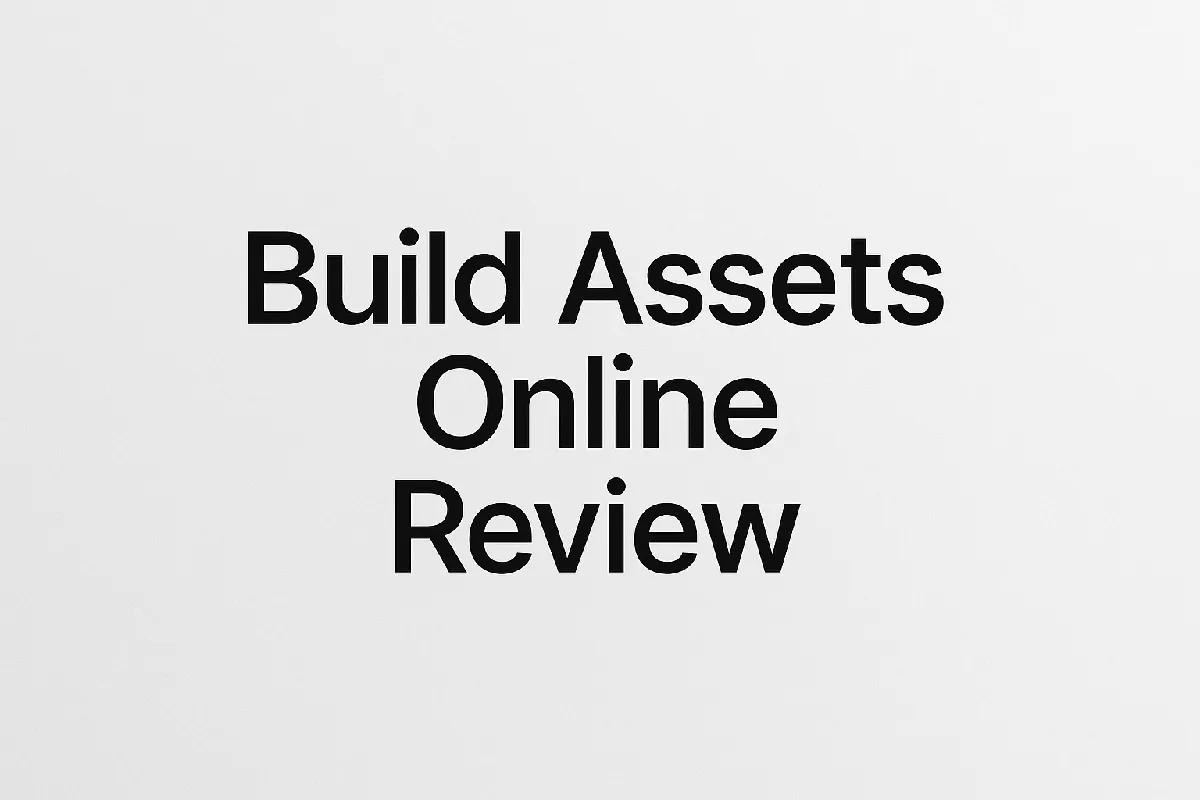Build Assets Online Review - My Experience With this High-Ticket Dropshipping Course
Welcome to this Build Assets Online review. The program leans on high-ticket dropshipping.
Instead of selling low-cost gadgets, the focus is on bigger-ticket items — products that can bring in larger profits per sale.

They claim that this creates a more sustainable business model, where fewer transactions can still generate meaningful revenue.
From my own perspective, this has its appeal. The training is structured, with step-by-step guidance on finding suppliers, setting up a store, and running ads that target high-value searches.
I also noticed that support goes beyond generic lessons, with things like live calls, site audits, and ad account reviews.
That extra layer does make a difference if you’re new and don’t want to figure everything out alone.
The trade-off is the price tag and the workload. Enrollment is expensive, and the ongoing ad spend required to drive traffic adds even more.
On top of that, running a dropshipping store still comes with challenges — dealing with suppliers, keeping ads profitable, and competing with others using similar strategies. For beginners, this can quickly feel overwhelming.
So, my quick summary is that this program is best suited to people who want a structured pathway into high-ticket dropshipping and who are prepared to invest both time and money.
It isn’t a shortcut, but it does provide tools that can cut down on guesswork if you’re serious about the model.
Pros
Step-by-step guidance for high-ticket dropshipping
Includes coaching, audits, and ad reviews for extra support
Focus on larger profits per sale instead of low-ticket volume
Cons
Expensive upfront and ongoing ad costs
Still requires persistence with suppliers and ads
Can overwhelm beginners without prior business experience
What I’ve learned from reviewing and testing out programs like this is that the bigger challenge isn’t just the content — it’s understanding why so many people still don’t get the results they expect.
If you’ve wondered about that too, there’s a resource I recommend checking out here.
Who Runs Build Assets Online?
The operation behind this platform is led by two brothers, Mike and Joe Brusca, who have built a reputation over the past decade around e-commerce and digital asset strategies.
Their public narrative often traces back to early side hustles: Joe started with retail arbitrage on Amazon, while Mike experimented with Kindle publishing.
As one thing shifted or became risky, they pivoted — eventually landing on high-ticket dropshipping as their main vehicle.
Their shift wasn’t accidental; it appears to have come from necessity as much as design.
They frequently emphasize a portfolio approach.
In other words, the dropshipping stores aren’t the only components of their online business — they also operate niche sites, publish books, and maintain digital brands that interconnect.
The idea, according to them, is not to tie all your hopes into a single income source.
Dropshipping is positioned as the core “engine” of their model. Their claim is that they focus only on higher-ticket items, sourced from U.S.-based brands (rather than cheap imports), and use Google Ads as their primary traffic method.
They argue this avoids many of the classic pitfalls of cheap gadget dropshipping—like razor-thin margins and advertising bans.
One notable point is how they frame their own track record. They cite store exits, reports of recurring revenue, and claims of decades of combined experience.
For example, they’ve spoken in interviews about selling one of their stores for six figures and scaling multiple stores simultaneously.
But when you dig deeper, verifying those claims depends on take-it-on-faith testimonials and external reviews with varying degrees of skepticism.
In my view, their background does position them as credible players in the high-ticket dropshipping space.
Yet their narrative also blends performance claims and marketing — so it becomes important to scrutinize how much of the story is verifiable vs. aspirational.
My Personal Experience With Build Assets Online
When I first stepped into this program, I was curious how different it would feel from other dropshipping courses I’ve tried.
Right away, the biggest difference was the emphasis on selling higher-priced products instead of cheap impulse buys.
That shift sounded good in theory — fewer sales needed to make meaningful revenue — but putting it into practice was more challenging than I expected.
The training itself was structured, which I appreciated. It walked me through choosing a niche, reaching out to suppliers, and setting up a store.
I also had access to coaching calls, which were helpful for clarifying questions when I got stuck.
Still, the real test came once I started running ads. Google Ads was the main traffic source taught, and while the guidance was clear, the costs added up quickly.
It wasn’t as simple as turning on campaigns and watching sales roll in. I had to constantly tweak targeting and adjust budgets to see progress.
Working with suppliers was another part of the process that felt different from the usual dropshipping setup.
Instead of pulling random products from overseas marketplaces, I had to build relationships with U.S.-based brands.
That did make the store feel more legitimate, but it also meant slower onboarding and higher standards from suppliers before they agreed to work with me.
Overall, my experience was mixed. The framework gave me direction and helped me avoid common beginner mistakes.
But at the same time, the model required more capital and persistence than I initially expected. It wasn’t something I could treat like a side project — it demanded focus and consistent effort.
What's Build Assets Online's Pricing and Refund Policy?

One of the first things that stood out to me was how expensive this program is compared to most other dropshipping courses.
Instead of a one-time fee in the low hundreds, the membership is structured as a subscription.
At the time I reviewed it, the Grow plan was priced at $399 per month or $3,999 annually, while the Scale plan came in at $599 per month or $5,999 annually.
That’s a serious commitment, especially when you factor in that these fees are only the cost of the training and support — not the business expenses that come with running ads, building a store, or working with suppliers.
For me, this meant doing some math early on. It wasn’t enough to ask, “Can I afford the course?” I had to consider whether I could also maintain an advertising budget big enough to test campaigns properly.
Without steady ad spend, the training itself wouldn’t matter much. That’s something I think many newcomers underestimate when they first look at the program.
As for refunds, the policy is strict. There isn’t much flexibility if you decide after a month or two that dropshipping isn’t right for you. From my perspective, that raises the stakes even more.
Once you’re in, you’ve essentially committed to paying at least the initial period with little chance of reversing the decision.
In short, the pricing reflects the seriousness of the model. It’s not designed for dabblers or people who want to experiment cheaply.
The subscription format, combined with the strict refund stance, signals that the program is built for those willing to commit long-term to high-ticket dropshipping and all the financial demands that come with it.
Looking at the price made me realize the real challenge isn’t just paying for the program — it’s everything that comes after.
Most people don’t see that until they’re already in the middle of it. If you want a clearer picture of why so many get stuck, you’ll find it here.
What's Inside Build Assets Online?
When I went through the training, the structure was one of the stronger points. Instead of a loose set of videos, the material is organized into a clear progression.
It starts with niche selection and moves into supplier outreach, store setup, and running ads. That order matched what I actually needed to do in practice, which made it easier to stay on track.
The support tools built into the program also stood out. Alongside the core lessons, there were checklists that helped me avoid missing small but important steps, like handling shipping policies or setting up call scripts.
There was also access to group calls and one-on-one sessions depending on the plan.
For me, having the ability to ask direct questions was helpful, especially when I hit roadblocks with ad targeting or supplier negotiations.
Another feature was the site and ad account reviews. Submitting a store or campaign for feedback felt like having a second set of eyes, which saved me from wasting money on obvious mistakes.
I also noticed the training is updated to reflect changes in Google Ads and SEO, which matters since both areas shift constantly.
That said, no amount of structure eliminated the work involved. Even with templates for supplier emails or ad frameworks, I had to adapt them to fit my niche.
There was also a learning curve with call handling — something I hadn’t dealt with in other dropshipping courses.
Overall, the features provided a strong framework and support system. But as I found out, the tools only take you so far.
The real results depend on consistent testing, budget management, and the effort you put in once the training steps into real-world execution.
What Are The Build Assets Online Student Results and Testimonials?

Looking at student results was one of the first things I did before diving in fully.
The official site highlights a number of success stories, many of which show students scaling stores into six-figure revenue ranges.
At first glance, these stories are encouraging — they reinforce the idea that the model works when executed well.
Some interviews even walk through details of what niches people chose and how they handled supplier relationships, which gave me a better picture of what’s possible.
But as I compared those stories to broader feedback online, the picture became more complicated. Outside of the program’s own platform, testimonials are harder to verify.
I noticed that many of the results being showcased leaned toward best-case scenarios rather than typical outcomes.
That doesn’t make them false, but it does set expectations high, especially for new students who might assume those numbers are standard.
From my own experience, I found myself somewhere in between. I didn’t hit the dramatic revenue figures being shared on the site, but I did manage to generate sales after putting in consistent effort.
What stood out to me was how long it took before the store gained traction. Ads had to be tested, supplier terms had to be negotiated, and calls had to be handled professionally.
Those small hurdles slowed things down, which I think is a more realistic reflection of what most students face.
So, while there are people who achieve impressive results, the more common experience seems to be steady progress with plenty of trial and error along the way.
For anyone considering the program, it’s important to keep in mind that the published success stories show what’s possible — not necessarily what’s typical.
Pros and Cons of Build Assets Online
After spending time with this program, I found myself weighing its strengths and weaknesses carefully.
On the positive side, the structure was clear. Compared to other courses I’ve tried, the step-by-step format gave me a sense of direction rather than leaving me piecing things together on my own.
The focus on high-ticket products also felt like a smarter play than chasing low-priced items.
It made the numbers work out in a way that felt more sustainable, at least in theory. I also can’t overlook the support.
Having access to audits and coaching calls meant I didn’t have to second-guess every decision.
That said, the downsides were equally noticeable. The cost was one of the biggest.
Not only was the membership itself expensive, but the ad spend required to test campaigns stretched my budget.
It felt like a double commitment — paying for the program while also needing to pour money into traffic.
Another drawback was the complexity. While the system is broken into steps, there are still a lot of moving parts: supplier outreach, ad management, call handling, and store optimization.
At times, I felt overwhelmed trying to keep everything running smoothly.
Another challenge was expectations. The official success stories highlight big wins, but my own progress was slower and less dramatic.
That mismatch left me questioning whether I was behind or simply experiencing the more typical path.
Overall, I’d say the pros are in the structure and support, while the cons are in the financial and mental demands.
It’s not a quick or easy model, but for the right person, the framework does provide tools that can help cut down on guesswork.
Who is Build Assets Online For?
As I worked through the material, it became clear to me that this program isn’t meant for everyone.
The structure, pricing, and level of commitment point toward a very specific type of student. In my opinion, it’s best suited for people who already have some stability — both financially and in terms of time.
The high-ticket dropshipping model demands upfront investment, and without a consistent ad budget, it’s almost impossible to see results.
That rules out anyone hoping to get started with pocket change or spare time on weekends.
I also think it’s geared toward individuals who thrive on structure and accountability.
The coaching calls, audits, and support systems are useful if you’re the kind of person who likes following a clear path.
If you prefer figuring things out independently or hopping between different side hustles, the framework may feel too rigid.
From my own perspective, it’s also a better fit for people who can handle setbacks without getting discouraged.
Running ads that don’t convert, dealing with suppliers who are slow to respond, and learning to close sales over the phone are all part of the process. If frustration makes you quit early, the financial loss will feel painful.
So, who is it best for? I’d say serious learners with money to invest, patience to test campaigns, and determination to work through the slower parts.
It’s not designed for casual beginners, but for those who want to treat dropshipping as a real business rather than a quick side hustle, the program does provide a system that can guide them along the way.
Build Assets Online Common Criticisms
When I looked into this program, I paid close attention to the criticisms that came up repeatedly.
One of the most common is the high price point. Between the monthly subscription and the additional ad spend, the costs quickly add up.
From my own experience, this isn’t an exaggeration — I felt the financial pressure almost immediately.
It’s one thing to pay for training, but it’s another to keep pouring money into ads while you’re still learning.
Another criticism is how overwhelming the model can feel. Even though the lessons are organized, the reality of managing a store, running campaigns, and working with suppliers hits hard once you’re in the middle of it.
I experienced this myself when juggling ad optimizations with supplier emails and customer calls. It’s easy to get stretched thin, especially if you’re new.
There’s also skepticism about the results shown on the official site. The testimonials highlight students who scaled quickly, but it’s less clear how many people hit average or below-average outcomes.
From my perspective, the wins are real but not typical. My own results were slower, which made me more cautious about taking the showcased success stories at face value.
Finally, some people view the refund policy as a red flag. It’s strict, leaving little room to back out once you’ve committed.
In my case, this made the decision to join feel weightier than other programs I’ve tested.
Overall, the criticisms don’t necessarily mean the system doesn’t work, but they do highlight risks that can catch newcomers off guard.
Knowing these upfront helped me set more realistic expectations about what it would take to make progress.
Final Verdict
After spending time with this program, my overall impression is that it offers a solid framework for high-ticket dropshipping but isn’t a perfect fit for everyone.
On the positive side, the structure is clear, the support is strong, and the focus on higher-priced products makes more sense to me than chasing low-ticket items.
The idea of building digital assets with long-term value is also something I found appealing. It gave me a reason to think beyond quick wins and consider sustainability.
That said, the challenges were hard to ignore. The cost of the program itself is steep, and the ongoing need for ad spend made it even more demanding.
I also found that progress was slower than the official testimonials might suggest.
Success stories highlight big results, but my experience showed me that steady progress with setbacks along the way is a more realistic outcome.
For beginners, that can be discouraging if expectations aren’t managed carefully.
For me, the biggest takeaway is that this program is designed for serious learners who are ready to commit both time and money. It isn’t a shortcut or an easy entry point into e-commerce.
It’s more like a guided system that reduces trial and error if you’re willing to stick with it through the difficult parts.
In the end, I don’t regret trying it because it gave me clarity about the demands of high-ticket dropshipping.
But I also see why many people struggle. If you’re considering it, the key question to ask yourself is whether you’re prepared for the financial and mental investment it requires.
Without that, even the best training won’t deliver the results you might be hoping for.
What stuck with me most wasn’t just the framework itself, but realizing how often people still miss the mark even with step-by-step guidance.
If you’ve ever wanted to see why that happens, you can take a look here.